Horizon Hobby Blade Trio 180 CFX BNF Basic
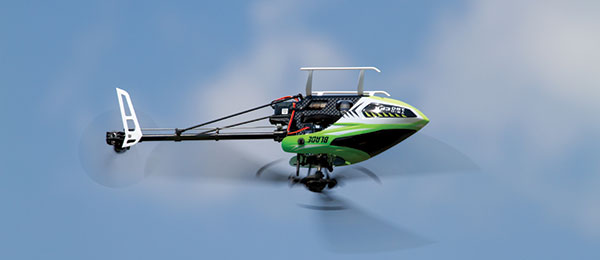
Written by Greg Gimlick A 3-D-ready micro machine Product review As seen in the December 2017 issue of Model Aviation.
Bonus Video
Specifications
Model type: Electric BNF micro flybarless Skill level: Intermediate to advanced Main rotor diameter: 14.2 inches Head geometry: 120° Tail drive: Torque tube Tail rotor diameter: 3.6 inches Size: 180 Length: 13.4 inches Height: 5.1 inches Weight: 7.7 ounces with battery Power system: 5,800 Kv brushless outrunner ESC: Castle Creations Talon 15 ESC Flight battery: E-flite 11.1-volt 450 mAh 3S 30C LiPo Flight duration: 3 minutes Radio: Spektrum DX9; AR6335 receiver (included); three nanolite high-speed heli servos (included); one 7.6-gram submicro digital tail servo (included) Minimum flying area: Gymnasium Price: $249.99 (BNF)Pluses
• Ready to fly right out of the box using your Spektrum radio. • Carbon-fiber frame and aluminum servo mounts. • Castle Creations Talon ESC. • Three-blade head for excellent collective and cyclic authority. • Spektrum AR6335 Nanolite receiver with AS3X flybarless technology. • Optimized servo geometry and metal-geared servos. • Setup files downloadable from Spektrum.Minus
• Tail rotor torque tube breaks easily, but saves the gears and shaft.Product Review
I opened the Horizon Hobby Blade Trio 180 CFX BNF Basic with some preconceived opinions. Because I had already owned the original two-blade 180 CFX, I expected excellent quality and I wasn’t disappointed. Like its predecessor, it comes out of the box almost ready to fly except for installing the blades and a bit of programming. It has a full carbon-fiber frame, fully supported aluminum tailboom, and uses “real” servos. I also like that it uses an inexpensive 3S LiPo pack and a JST plug rather than a proprietary connector.Construction
Digital, metal-geared servos are mounted inside carbon-fiber frames with “optimized servo geometry,” which is Blade-speak for mounting them with the benefit of a straight-line geometry most micros attain by using weaker linear-style servos. The stronger digital rotary servos used in the 180 CFX are optimized by the new aluminum mounts designed for this machine.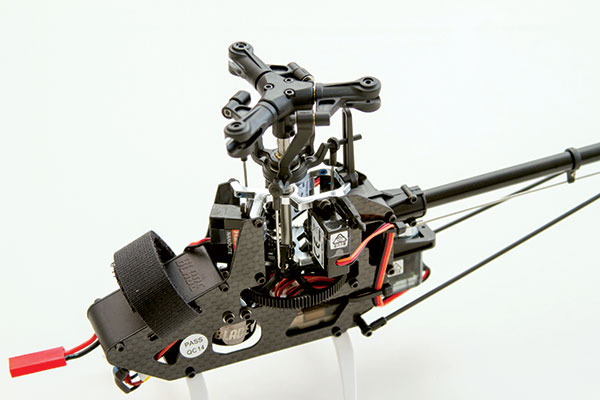
A view of the left side shows the optimized servo positioning on aluminum mounts. Note the sturdy drive links on the direct flight control head.
The tail drive assembly resembles that of a much larger machine, complete with dual support arms. It utilizes a torque tube and a one-piece tail rotor gearbox. The gearbox is easily removed by popping the control linkage off and removing one screw. After you do that, the gearbox slides off of the aluminum tailboom and the torque tube slides right out. Why is this important? Well, that torque tube is a sacrificial piece of the drivetrain in the case of a tail rotor strike. If you fly from grass instead of pavement, it becomes important because sticking the tail rotor into a clump of grass will break the ends of the torque tube, but will not damage any of the gears or the shaft. It will break with only slight contact with the ground, but it takes less than 5 minutes to repair and the parts are inexpensive. If you fly from a smooth surface, it won’t be an issue.
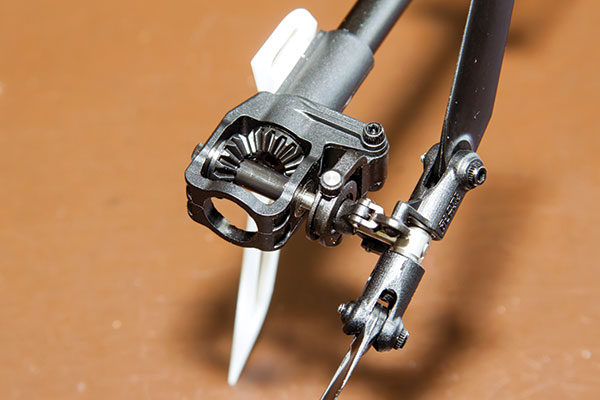
The tail drive is the same efficient unit used on the previous two-blade 180 CFX.
One problem some helis encounter with torque tubes is a wobble in the middle of the tailboom. This has been addressed in the Trio 180 CFX by adding a bearing near the center of the torque tube to support it. When you replace a broken torque tube, simply shake the broken pieces out and slide the new tube in. There is no gear lash to adjust because everything is set to lock in the exact location necessary. Replace the screw, snap on the linkage, and you’re back in the air. Blade uses a Castle Creations Talon 15 ESC, so you can tweak the settings with a Castle Link, if needed. I don’t know why you’d have to do that, but for anyone who likes to adjust things, it is an option. Great tech support is available from Castle Creations. The ESC is paired with a 5,800 Kv outrunner motor driving a beefy main gear with a metal pinion gear. This is a much sturdier drive than you find on most micros helis. The receiver is buried inside of the frame. Fortunately, someone thought of installing a binding plug extension mounted to the side of the frame so that it’s easily accessible. The receiver is a Spektrum AR6335 six-channel receiver with AS3X flybarless technology. This delivers high-speed stability and precision.
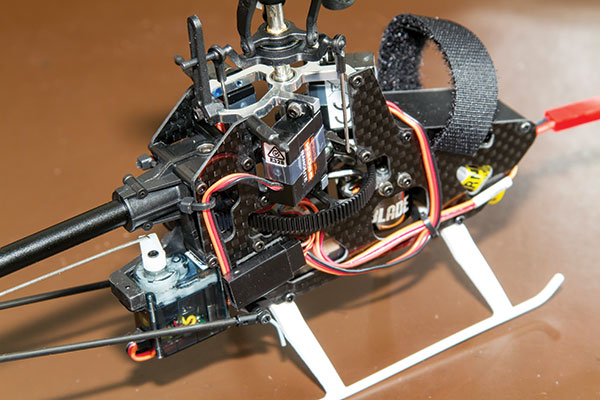
The right side of the Trio 180 CFX shows the binding plug that has been affixed to the side where it’s easily accessible. The tail rotor servo is also seen in this view.
It was a simple process to program my DX9 transmitter. The manual lists setups for Spektrum radios and it’s easy to follow, but you can also download the setup file for your radio from the Spektrum website.
Flying
I couldn’t wait to get this thing to the field, but a stretch of days in North Carolina, with 108° heat indices, gave me pause. Finally, a nice comfortable 94° day presented itself and off I went. Hey, it’s all relative, right? The 7-ounce Trio 180 CFX is not designed for windy days, but I did fly it in breezes up to 10 mph. That bounced the little heli around more than I was comfortable with, but it handled the conditions well. This machine has monster power! I was really surprised by its authority as soon as I advanced the throttle and increased collective. The machine is agile and I suggest that if you’re not an expert flier, have it test-flown by someone who is. I made my initial test flight then handed the Trio 180 CFX to Daniel Lamb, who is a member of my park flyer club. Daniel, an experienced 3-D pilot, gave it a workout.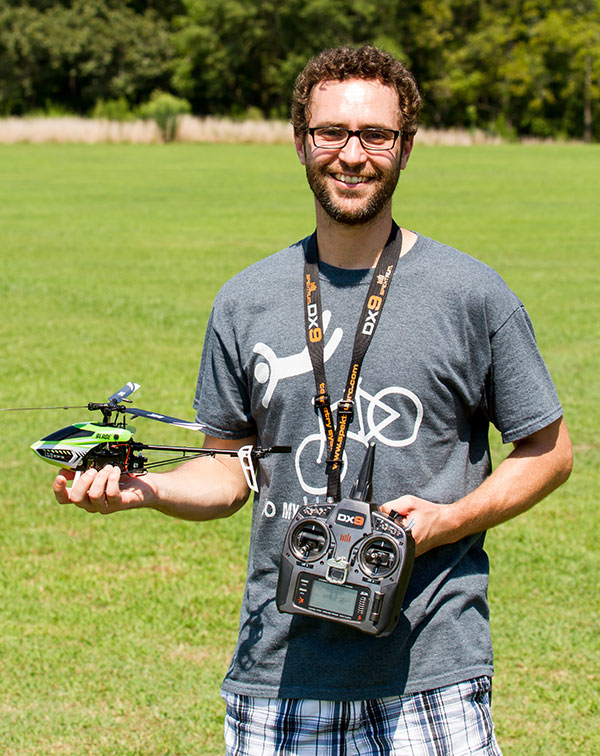
Daniel Lamb stepped up to test the machine’s 3-D capabilities.
Daniel wasted no time getting it into 3-D mode by punching out instantly and bringing it back down to us inverted. He immediately exclaimed, “This feels good!” From there on out, it was hold on! There weren’t any maneuvers he tried that it wasn’t capable of performing. He often mentioned how he expected one thing or another to fade, but it didn’t. The tail was one of the best he has experienced in a micro-size heli and on par with much larger aircraft. Inverted punch-outs didn’t seem to fade the power as Daniel expected, and the tail held solid. Several times during and after his flights, he commented on how well the tail held under all conditions. I could tell by his smile that Daniel was happy flying the Trio 180 CFX. I was trying frantically to shoot photos and I think he used that as an excuse for one more flight so that I could get more. What a clever guy! After several flights, we sat down to compare notes. We went over each factory setting and discussed what we expected and how the aircraft compared. Daniel commented that he thought the settings were as close to perfect as one could expect, and the only thing that he might change was the throttle curve for normal mode.
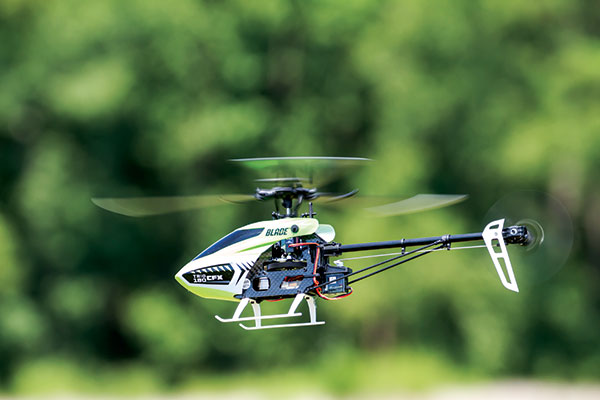
The green color scheme stands out well in the air and helps with orientation.
Daniel said that he would prefer the difference between the top throttle point in Normal mode to be closer to the Stunt 1 setting so there wasn’t such a marked increase in rpm. It wasn’t a problem, but it was a personal preference.










Add new comment